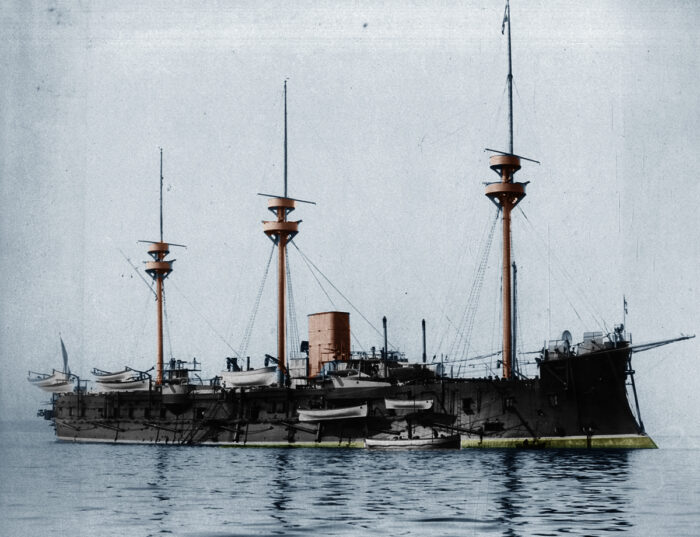
The French ironclad Richelieu was a wooden-hulled central battery ironclad started before the Franco-Prussian war and completed after a redesign in 1875. She was named after the 17th century statesman and Cardinal, designed by Dupuy de Lôme as an improved Ocean class, with her main guns in barbettes and a two-stage central battery. She became flagship of the Mediterranean Squadron for most of her career, but caught fire in 1880, and was scuttled to prevent her magazines from blowing up. Salvaged later, fully repaired and modernized, she returned as flagship until placed into reserve in 1886 and condemned in 1901. As a ship which did not want to end in a scrapyard, while towed in the Bay of Biscay on her way to Amsterdam, her line was cast loose to not bring her tug under during a storm. She survived, located later drifting away near the Scilly Isles, and was tugged to her final destination anyway.
Design of Richelieu (1868-69)
Hull & general appearance

Henri Dupuy de Lôme, French superstar designer, which signed all major French warships since the 1850 Napoléon, designed the Richelieu as an improvement over his previous Océan-class ironclads. As a central battery ironclad, she had her armament concentrated amidships but in a two-storey arrangement between a classic concentrated broadside and upper heavy guns in barbettes for a better arc of fire. She combined this with an improved plough-shaped ram projecting no less than 10 feet (3 m) from her hull, and a 3-masted barque rigging typical of her day. Her appearance changed during her career, and her crew numbered around 750 officers and men, counting on a fleet of 16 boats of various types, some under single davits, and eight aft under double davits.
Richelieu was substantially larger than the Ocean class, measuring 101.7 meters (333 ft 8 in) overall for a beam of 17.4 meters (57 ft 1 in) and had a maximum draft of 8.5 meters (27 ft 11 in) while displacing 8,984 metric tons (8,842 long tons). She had a tall and short forecastle, then a continuous deck with bulwarks down to the poop. Her metacentric height was very low, at just 1.5 feet (0.5 m) so her roll was long and manageable for the crew, but she was at greater risk of overturning. The master idea was to make her more agile and better as a ram.
Powerplant
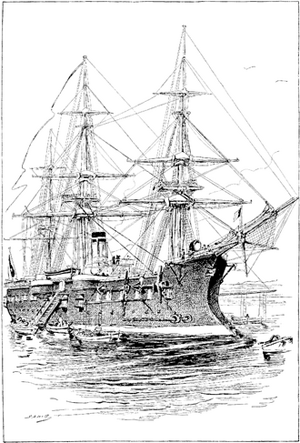 To be better at manoeuvring, Richelieu was given by Dupuy de Lôme de advantage of two propellers instead of a single one for the Ocean class and the preceding Friedland. Henri Dupuy de Lôme homed to use the power plants themselves to moderate speed and increase the efficiency of the axial rudder. She needed to out-turn other ships in melee, giving her a decisive advantage for ramming. The engines chosen were two Indret 3-cylinder horizontal return connecting rod (HRCR). These were compound steam engines driving each a single large bronze 2-bladed propeller. These engines were fed by eight Indret oval boilers.
To be better at manoeuvring, Richelieu was given by Dupuy de Lôme de advantage of two propellers instead of a single one for the Ocean class and the preceding Friedland. Henri Dupuy de Lôme homed to use the power plants themselves to moderate speed and increase the efficiency of the axial rudder. She needed to out-turn other ships in melee, giving her a decisive advantage for ramming. The engines chosen were two Indret 3-cylinder horizontal return connecting rod (HRCR). These were compound steam engines driving each a single large bronze 2-bladed propeller. These engines were fed by eight Indret oval boilers.
On trials based on 4,600 indicated horsepower (3,400 kW) she managed to reach 13.2 knots (24.4 km/h; 15.2 mph) for a contracted speed of 13 knots (24 km/h; 15 mph), earning her builder, Arsenal de Toulon, to be awarded bonuses. She carried 640 metric tons (630 long tons) of coal, a bit more on Friedland, but was slower than the latter. This enabled her a range of 3,300 nautical miles (6,100 km; 3,800 mi) on coal alone at 10 knots (19 km/h; 12 mph) however, more than the 2200 nm of her predecessor. Richelieu had a square rigging initially to reach distant station by preserving coal, but seemed not to be an efficient sailing ship. Her three masts were soon cut down and simplified as a schooner rig. Later in 1982, they received military masts.
Protection
Richelieu was given a belt armour 220 mm (8.7 in) strong, in wrought iron at the waterline. Both the sides and battery transverse bulkheads were armoured and had 160 millimetres (6.3 in) of wrought iron as well. The barbettes were wilfully left unarmoured due to weight balance issue, and there was at first no mask to protect the gun operators. But the armoured deck was protected by 10 mm (0.4 in) of iron plating. Meanwhile, steel casting and foundry techniques for very large parts were progressing. This would lead to the construction of the Redoutable class, just a step after the Richelieu, which was Colbert class, started in 1870. They were the last French ironclads, effectively only protected by wrought iron.

Battery Deck illustration
Armament
Like the Ocean class, she had four identical guns in barbettes, four Canon de 24 C modèle 1870 on her upper deck open barbettes, covering all corners of the battery. In contrast, the preceding Friedland only had two larger guns (274mm) forward. The remainder were larger guns, six 274 mm (10.8 in) on the battery deck, below the barbettes. This was the only choice to preserve stability. There was also a supplementary 240 mm mounted in the forecastle, acting as chase gun. Her secondary armament was still generous, comprising ten 120 mm (4.7 in) guns, later replaced by six 138 mm (5.4 in) guns.
Main: Four Barbette 240 cm (9.4 in) M1870
These guns were made by Ruelle Foundry in 1870, they derived from the earlier Canon de 24 C modèle 1864, switching from muzzle-loading to breech-loading guns but still using cast iron gun barrels for cost, speed and ease of manufacture. The 1864 models entered service in 1867 with steel hoops and shells three times heavier than previous round bullets for the muzzle velocity of 334–345 m/s.
The 1870 system had its barrel also hooped, but it was built from a short steel inner tube increasing longitudinal strength which had many shallow grooves instead a few deep grooves. Internal Pressures could grow 50% higher. Their obturator was made by a ring of red copper and the ignition took place via the breech block, starting in the centre of the bottom part of the charge for more regular initial velocities, less strain on the gun. It used also a less offensive gunpowder, longer projectiles with copper driving bands and bourrelet. Performances were greatly improved across the board.


Characteristics (1870M):
Type: Separate-loading, bagged charge and projectiles
Mass & Dimensions: 15,660 kg or 15.41 long tons, 4.940 m (16.21 ft) L/21.
Shell: AP 317.5 pounds (144.0 kg). Muzzle velocity 1,624 ft/s (495 m/s). Penetration 14.4 inches (366 mm) wrought iron at the muzzle.
Elevation/rate of fire: 30°, 1 round every two minutes.
Effective range: 10 km (6.2 mi) basic and 10.8 km (6.7 mi) for the 1870 M
Main: Six Central Battery 274 cm (10.4 in) M1870
The 22.84 long tons (23.21 t) 18-caliber 274 mm Modèle 1870 gun fired an armour-piercing (AP) 476.2-pound (216.0 kg) shell at a muzzle velocity of 1,424 ft/s (434 m/s) and was capable of defeating 14.3 inches (360 mm) of wrought iron armour at the muzzle. See the previous post on Friedland for more details.
Secondary: Ten 12 cm (4.7 in)
No data so far.
Secondary (upgrade): Ten 13.8 cm (5.4 in)
This was a 21 calibers, 2.63 long tons (2.67 t) model, which fired a 61.7-pound (28.0 kg) HE shell at a muzzle velocity of 1,529 ft/s (466 m/s), but also was capable of fitring classic solid shots, and had stores of it. It was mostly used against fortifications.
Later: 47/37 mm Hotchkiss (6-3 pdr.)
47mm: No data.
Later in her career, Richelieu received eight, and then later ten more, 37 mm (1.5 in) Hotchkiss 5-barrel revolving guns, firing a 500 g (1.1 lb) HE shell at a muzzle velocity of 610 m/s (2,000 ft/s) to a range of c3,200 meters (3,500 yd). Rate of fire was 30 rounds per minute.
TTs: 2-4 356 mm tubes (14 in)
In 1884, two above-water 356-millimeter (14.0 in) torpedo tubes were added.
⚙ Richelieu specifications as built |
|
| Dimensions | 101.7 x 17.4 x 8.5m (333 ft 8 in x 57 ft 1 in x 28 ft) |
| Displacement | 8,984 metric tons (8,842 long tons) |
| Propulsion | 2 shafts, HRCR steam engines, 8 oval boilers: 4,600 ihp (3,400 kW) |
| Speed | 13 knots (24 km/h; 15 mph) |
| Range | 3,300 nm (6,100 km; 3,800 mi) at 10 knots |
| Armament | 6× 274 mm (10.8 in), 5× 240 mm (9.4 in), 10x 120 mm (4.7 in) |
| Protection | Belt 220 mm (8.7 in), Battery 160 mm (6.3 in), Bulkheads 100 mm (3.9 in), Deck 10 mm (0.4 in) |
| Crew | 750 |
Richelieu’s career (1876-1900)
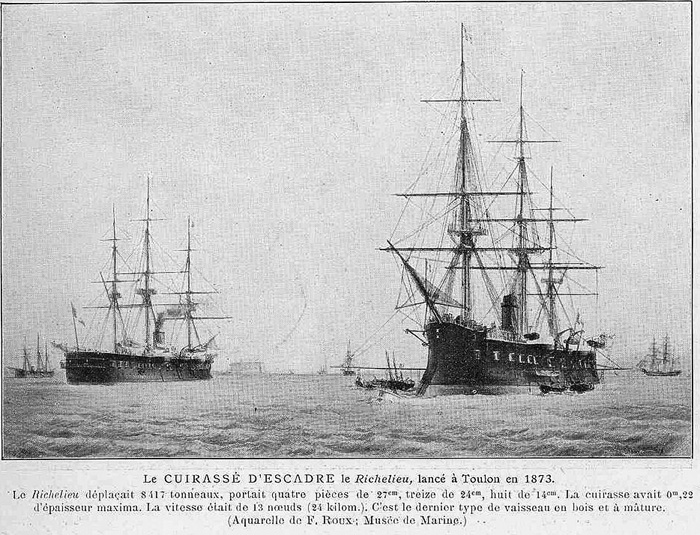
Richelieu was laid down at the Arsenal de Toulon (French Riviera) in 1869, but only launched on 3 December 1873, and had prolonged construction time as result as a mix of financial pressures caused by slashing French Naval budget after the Franco-Prussian War of 1870–71, outdated work practices and lack in investment in the arsenal’s infrastructures for decades, as well as probably design changes overtime due to succeeding ministers, the classic illness of French naval construction and planning at the time. Toulon was part of these antiquated French dockyards that completely missed the Industrial Age. Still, six years was relatively reasonable when Richelieu was completed and started her sea trials on 12 April 1875, but she needed fixes and more trials, and only entered service with the Mediterranean Squadron as flagship (as she was the largest French capital ship at the time), from 10 February 1876. She was placed in reserve on 3 December 1879, due to budget constraints.
While anchored in Toulon harbour on 29 December 1880, she caught fire. The exact reasons why it started was never completely established by the later enquiry commission. Some argued this was likely an unauthorized bagged storage too close to a machinery bulkhead, while raising steam, or just poor cooling inside the hull in storage spaces. Whatever the root cause, she had to be scuttled to prevent her magazines from exploding as the fire progresses quickly. This was done simply by opening water pump cocks. She capsized however due to her unequal stability, and settled, laying on the bottom under 10.75 meters (35.3 ft) of water, her barbettes at a 90° angle. Immense efforts were procured to salvage her, her ammunition, masts, armour and movable decks were all removed. A massive weight was gradually loaded into her holds to lower her centre of gravity, and a system of cranes and pulley was set in place. A sheer hulk was moved to her port side, cables were connected to the ship Sybille on the other side, with 360 empty casks, 34 cubic meters (1,200 cu. ft.) of attached to starboard o prevent her from rolling too far the other way. The final effort after weeks of preparations took one hour and a half of lifting until she reached a 45° angle, and more applied a day later to reach her straight level.
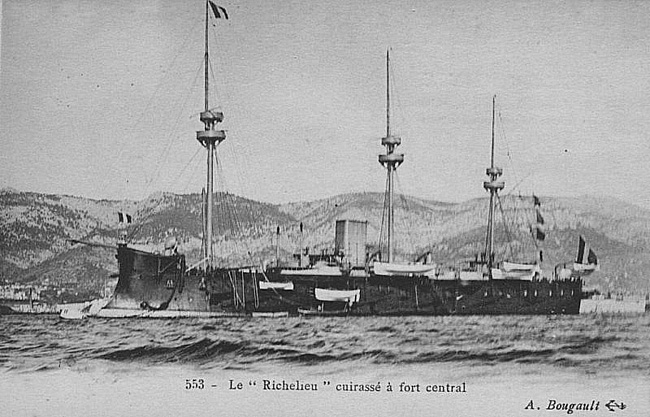
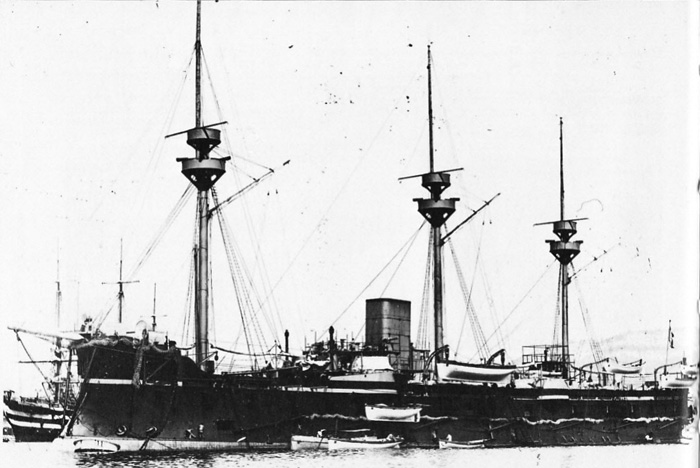

Richelieu then was towed to the dry-dock and needed long repairs due to all seawater that seeped into the entire internal hull and sat for a time, saltwater degrading everything. She also was modernized at the time, with her schooner rig further simplified, having just the composite masts with all three a fighting top with a 37mm Hotchkiss 6-barreled gun and a spotting top above. She returned into service as flagship of the Mediterranean Squadron again from 8 October 1881, almost a year since her scuttling. Likewise, she remained listed as such until 1886, despite better, more modern ironclads entered service in between.
Furthermore, she led the squadron in between for port visits such at Tangiers and Lisbon in 1884, and joined the Atlantic fleet for combined exercises, visiting Brest and Cherbourg. In 1885, Richelieu tested the Bullivant torpedo nets, folded onto her hull while underway. It was show they drastically reduced her speed down to 4 knots (7.4 km/h; 4.6 mph). They also aggravated her roll considerably. Trials were not considered successful as a result.
She returned to the reserve in 1886. She was later reassigned as flagship of the Reserve Squadron from 8 September 1892, still in official commission. The squadron sorties notably for exercises from June to August 1892. Richelieu was at last condemned on 5 March 1900 (stricken from the register), but her hull not immediately sold, laying at Toulon reserve for many more years. She was eventually sold to a ship breaking company operating in the Netherlands, at Amsterdam, in 1910. She departed Toulon on 28 January 1911 under tow. While underway in the Bay of Biscay, she was caught in a storm. It caused the tugboat to cast her loose to avoid being dragged to the bottom. Richelieu remained afloat. She started drifting after the storm abated, out of view from the tug. A search was launched. She was eventually recovered near the Scilly Isles, apparently having being tossed on to rocks, but without damaging the hull to the point of creating a breech. She was towed to Amsterdam eventually, and started to be broken up.
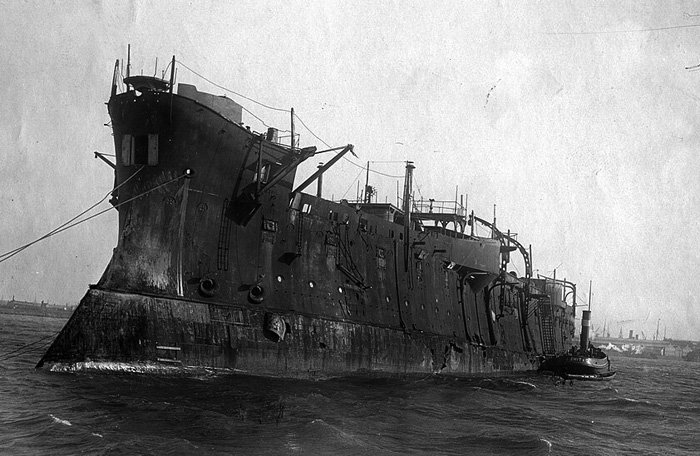
Richelieu being broken up at Amsterdam, 1911-12.
Read More/Src
Books
de Balincourt, Captain; Vincent-Bréchignac, Captain (1975). “The French Navy of Yesterday: Ironclad Frigates”. F.P.D.S. Newsletter. III
Campbell, N. J. M. (1979). “France”. In Chesneau, Roger & Kolesnik, Eugene M. (eds.). Conway’s All the World’s Fighting Ships 1860–1905.
Brassey, Thomas (1888). The Naval Annual 1887. Portsmouth, England: J. Griffin.
Roberts, Stephen S. (2021). French Warships in the Age of Steam 1859–1914: Design, Construction, Careers and Fates. Seaforth Publishing.
Ropp, Theodore (1987). The Development of a Modern Navy: French Naval Policy 1871–1904. NIP
Saibene, Marc (1995). “The Redoubtable, Part III”. Warship International. XXXII (1). Toledo.
Silverstone, Paul H. (1984). Directory of the World’s Capital Ships. Hippocrene Books.
Wilson, H. W. (1896). Ironclads in Action: A Sketch of Naval Warfare From 1855 to 1895. Vol. 2. Boston, Massachusetts: Little, Brown.
Links
https://www.navypedia.org/ships/france/fr_bb_richelieu75.htm
https://en.wikipedia.org/wiki/French_ironclad_Richelieu
https://en.wikipedia.org/wiki/Canon_de_24_C_mod%C3%A8le_1870
http://www.navweaps.com/Weapons/WNFR_Main.php
on archive.wikiwix.com/ Fjose.chapalain.free.fr



 Latest Facebook Entry -
Latest Facebook Entry -  X(Tweeter) Naval Encyclopedia's deck archive
X(Tweeter) Naval Encyclopedia's deck archive Instagram (@navalencyc)
Instagram (@navalencyc)


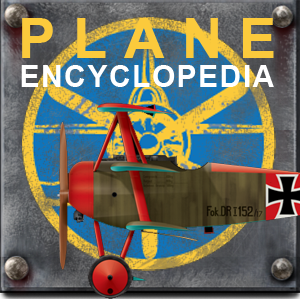
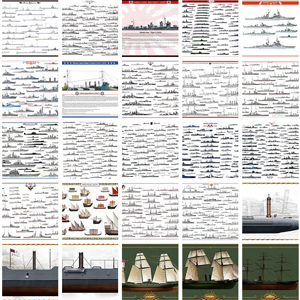

 French Navy
French Navy Royal Navy
Royal Navy Russian Navy
Russian Navy Armada Espanola
Armada Espanola Austrian Navy
Austrian Navy K.u.K. Kriegsmarine
K.u.K. Kriegsmarine Dansk Marine
Dansk Marine Nautiko Hellenon
Nautiko Hellenon Koninklije Marine 1870
Koninklije Marine 1870 Marinha do Brasil
Marinha do Brasil Osmanlı Donanması
Osmanlı Donanması Marina Do Peru
Marina Do Peru Marinha do Portugal
Marinha do Portugal Regia Marina 1870
Regia Marina 1870 Nihhon Kaigun 1870
Nihhon Kaigun 1870 Preußische Marine 1870
Preußische Marine 1870 Russkiy Flot 1870
Russkiy Flot 1870 Svenska marinen
Svenska marinen Søværnet
Søværnet Union Navy
Union Navy Confederate Navy
Confederate Navy Armada de Argentina
Armada de Argentina Imperial Chinese Navy
Imperial Chinese Navy Marinha do Portugal
Marinha do Portugal Mexico
Mexico Kaiserliche Marine
Kaiserliche Marine 1898 US Navy
1898 US Navy Sovietskiy Flot
Sovietskiy Flot Royal Canadian Navy
Royal Canadian Navy Royal Australian Navy
Royal Australian Navy RNZN Fleet
RNZN Fleet Chinese Navy 1937
Chinese Navy 1937 Kriegsmarine
Kriegsmarine Chilean Navy
Chilean Navy Danish Navy
Danish Navy Finnish Navy
Finnish Navy Hellenic Navy
Hellenic Navy Polish Navy
Polish Navy Romanian Navy
Romanian Navy Turkish Navy
Turkish Navy Royal Yugoslav Navy
Royal Yugoslav Navy Royal Thai Navy
Royal Thai Navy Minor Navies
Minor Navies Albania
Albania Austria
Austria Belgium
Belgium Columbia
Columbia Costa Rica
Costa Rica Cuba
Cuba Czechoslovakia
Czechoslovakia Dominican Republic
Dominican Republic Haiti
Haiti Hungary
Hungary Honduras
Honduras Estonia
Estonia Iceland
Iceland Eire
Eire Equador
Equador Iran
Iran Iraq
Iraq Latvia
Latvia Liberia
Liberia Lithuania
Lithuania Mandchukuo
Mandchukuo Morocco
Morocco Nicaragua
Nicaragua Persia
Persia San Salvador
San Salvador Sarawak
Sarawak Uruguay
Uruguay Venezuela
Venezuela Zanzibar
Zanzibar Warsaw Pact Navies
Warsaw Pact Navies Bulgaria
Bulgaria Hungary
Hungary

 Bundesmarine
Bundesmarine Dutch Navy
Dutch Navy Hellenic Navy
Hellenic Navy Marina Militare
Marina Militare Yugoslav Navy
Yugoslav Navy Chinese Navy
Chinese Navy Indian Navy
Indian Navy Indonesian Navy
Indonesian Navy JMSDF
JMSDF North Korean Navy
North Korean Navy Pakistani Navy
Pakistani Navy Philippines Navy
Philippines Navy ROKN
ROKN Rep. of Singapore Navy
Rep. of Singapore Navy Taiwanese Navy
Taiwanese Navy IDF Navy
IDF Navy Saudi Navy
Saudi Navy Royal New Zealand Navy
Royal New Zealand Navy Egyptian Navy
Egyptian Navy South African Navy
South African Navy






























 Ukrainian Navy
Ukrainian Navy dbodesign
dbodesign